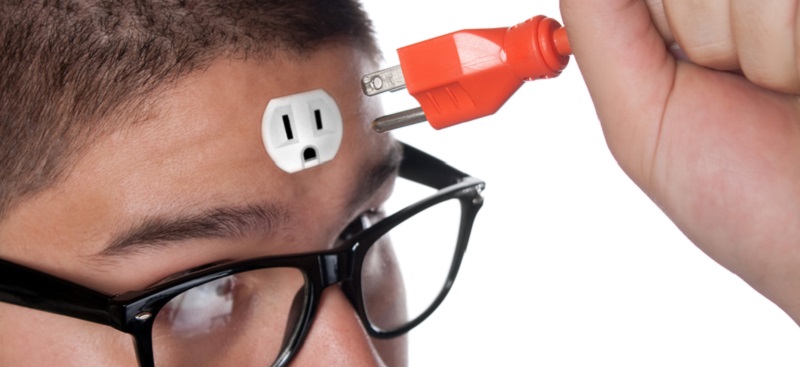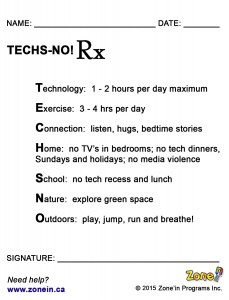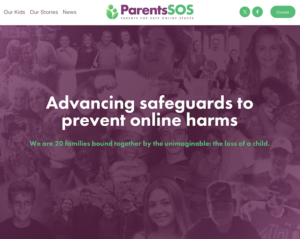Rowan, Cris. Journal of Ethical Human Psychology and Psychiatry,Vol 12, No 1, 2010.
The past decade has seen an increase in personal use of electronic technology, with childhood television and video game use similarly increasing. Critical milestones for child motor and sensory development are not being met. Simultaneously, there is an increasing incidence of childhood physical, psychological, and behavior disorders, often accompanied by the prescription of psychotropic medication. One in six children exhibit signs of poor health, mental stress, or problems at school. Exposure to an average of 8 hours per day of various forms of technology use has resulted in a physically sedentary yet chaotically stressed existence for Canadian children. The detrimental effects of technology use on critical milestones for child development are reviewed. This commentary by a pediatric occupational therapist outlines issues of concern for parents, family physicians, and pediatricians related to these trends and offers a novel treatment approach: Unplug — Don’t Drug.
CASE REVIEW
A 7-year-old boy was brought to his family physician’s office by his mother at the urging of his school. In attendance was his four 4-year-old sister. Discussion with the boy’s mother indicated that although his reading was at age level, the boy apparently had great difficulty producing school work and listening or paying attention in class and was reportedly “disruptive” and “aggressive.” The mother stated that her son had few friends, preferring instead to spend his time alone in his room watching television or playing video games. Initial assessment indicated that the son appeared pale with dark circles under his eyes, slightly obese, lethargic, and noncommunicative. Following a short period of questioning, the son became confrontational and combative with both the physician and his mother, abruptly leaving the physician’s office and returning to the waiting room. As the mother began to apologize for her son’s behavior, the physician began to take notice of the boy’s 4-year-old sister, who was positioned behind the mother. When questioned regarding her daughter’s health, the mother responded that the daughter frequently became upset and demonstrated high anxiety when experiencing normal everyday events. The mother went on to report that her daughter woke frequently in the night “screaming,” was overly sensitive to noise and light, and appeared to be “hooked” on cartoons— watching up to 6 hours per day.
CHILD HEALTH AND ACADEMIC PERFORMANCE
It wasn’t all that long ago that children were brought to their family physicians for fractures or lacerations sustained from falling out of trees or off bicycles. Today’s office visits are different. Physicians are now assessing and treating a variety of physical, psychological, and behavioral disorders in children that appear to be escalating at an alarming rate. One in six Canadian children have a diagnosed developmental disability (Hamilton, 2006), one in six are obese (Canadian Institute of Health Research, 2004), and 14.3% have a diagnosed psychiatric disorder (Waddell Hua, Garland, DeV, & McEwan, 2007). School-based occupational therapists observe increasing referrals of students to family physicians by their teachers for either attention impairments or learning difficulties. Subsequent child behaviors associated with these problems may be confusing for parents and teachers as well as the medical community and could be easily misunderstood, possibly resulting in psychiatric diagnosis and prescription of psychotropic medication (Mandell et al., 2008; Mukaddes, Bilge, Alyanak, & Kora, 2000; Ruff 2005). Between 1991 and 1995, prescriptions for psychotropic medications in the 2- to 4-year-old toddler population, as well as in children and youth, tripled (dosReis et al., 2005; Goodwin, Gould, Blanco, & Olfson, 2001; Zito et al., 2000; Zito et al., 2002), with 80% of this medication prescribed by family physicians and pediatricians (Zito et al., 2003). Twenty-eight percent to 30% of children receiving psychotropic medication are on multiple medications (dosReis, 2005). Limited evidence guiding appropriate dosing and inexperience in the documentation of long-term effects of these prescriptions in children may mean that these children undergo unquantified risks (Rosack, 2003; Kirsch & Antonuccio, 2004; Thomas, Conrad, Casler, & Goodman, 2006).
MEETING DEVELOPMENTAL MILESTONES
Throughout most of human history, child engagement in rough-and-tumble outdoor play resulted in the achievement of adequate sensory and motor development required for attention and learning (Ayres, 1972; Pelligrini & Bohn, 2005; Tannock, 2008). Increased usage of advanced technology has resulted in a physically sedentary society with sensory stimuli consisting of high frequency, duration, and intensity (Louv, 2005). Parents now spend 40% less time with their children than they did in the 1970s (Castro & Hewlett, 1991), impacting attachment development and socialization training. Children now immerse themselves for long durations in a virtual and often violent world, disconnecting from the world of physical play and meaningful interactions. In occupational therapy settings, children who overuse technology have described physical sensations of “body shaking,” rapid heart rate and breathing, and hyperacute vision and hearing. As these symptoms are typically associated with chronic high-adrenalin states in adults, one cannot help but wonder if technology overuse is creating chronic stress states in children. The three critical factors for healthy physical and psychological child development are movement, touch, and connection to other humans (Insel & Young, 2001; Korkman, 2001; Montagu, 1972). Developing children require 3 to 4 hours per day of unstructured, active rough-and-tumble play to achieve adequate stimulation to the vestibular, proprioceptive, and tactile sensory systems (National Association for Sport and Physical Education, 2002). This type of sensory input ensures normal development of core posture, bilateral coordination, and optimal arousal states (Braswell & Rine, 2006). Infants with low tone, toddlers failing to reach motor milestones, and children who are unable to pay attention or achieve basic foundation skills for literacy are now frequent visitors to pediatric physiotherapy, occupational therapy, and speech and language therapy clinics.
TECHNOLOGY USAGE STATISTICS
North American children now average 8 hours per day using a combination of non– school-related technologies (television, video games, movies, the Internet, cell phones, iPods, and other devices), with over 65% of children having televisions in their bedrooms (Nielsenwire, 2009; Rideout, Vandewater, & Wartella, 2003; Roberts, Foehr, Rideout, & Brodie, 1999). Active Healthy Kids Canada gave Canadian children a grade of D for inactivity, citing television and video games as the primary cause (Active Healthy Kids Canada, 2008). “Baby television” now occupies 2.2 hours per day for the 0- to 2-year-old population and 4.5 hours per day for 3- to 5-year-olds, and 60% of households have the television on all day (Nielsenwire, 2009; Rideout et al., 2003), as do a growing number of restaurants, cars, and even physicians’ waiting rooms. Parents who perceive outdoor play as “unsafe” allow higher usages of technology, further limiting access to developmental components usually attained in outdoor rough-and-tumble play (Burdette & Whitaker, 2006 ). Continuous use of technology has pervaded 21st-century society, but at what cost to child health and academic performance?
IMPACT OF TECHNOLOGY ON CHILD HEALTH AND ACADEMIC PERFORMANCE
Technology overuse by young children is associated with developmental delays (Thakkar, Garrison, & Christakis, 2006; Zimmerman, Christakis, & Meltzoff, 2007), prompting France to ban its broadcasters from airing television shows aimed at children under 3 years of age (Canadian Broadcasting Corporation, 2008). Incidence of infant “fl at head” has increased 600% in the past 5 years, with over two-thirds of physiotherapists in the United States reporting increasing incidence of infant “low tone” and subsequent failure to reach motor milestones ( Jennings, 2005). Television and video game use is evidenced to be a factor accounting for 60% of childhood obesity and is now considered a North American “epidemic” by physicians (Tremblay & Willms, 2005; Strauss & Pollack, 2001). Additional studies indicate technology overuse by children may be associated with attention difficulties, poor academic achievement, and sleep impairment (Christakis & Zimmerman, 2007; Hancox, Milne, & Poulton, 2005; Paavonen, Pennonen, & Roine, 2006). Dr. Dimitri Christakis found that each hour of television watched daily between the ages of 0 and 7 years equated to a 10% chance of attention problems by age 7 years (Christakis, Zimmerman, DiGiuseppe, & McCarty, 2004). While physical exercise has been repeatedly shown to significantly improve academic performance (Ratey & Hagerman, 2008) and access to “green space” significantly reduces attention deficit/ hyperactivity disorder and improves attention (Faber Taylor, Kuo, & Sullivan, 2001; Kuo & Faber Taylor, 2004), schools continue to allow unrestricted technology use during recess and are allowing playgrounds to fall into disrepair. While no one can argue the benefits of advancing technology in today’s world, many children are spending their days alone in dark rooms perfecting the “art of killing.” Desensitized to violence and lacking empathy, today’s child who overuses technology is hardwiring his or her brain for violent high-speed and fast-paced action, resulting in an unprecedented rise in child aggression, violence and crime (Anderson & Gentile, 2007; Anderson et al., 2008; Buchanan, Gentile, Nelson, Walsh, & Hensel, 2002; Murray et al., 2006). In the United States, the Academies of Physicians, Pediatricians, Psychologists, and Psychiatrists have joined with the American Medical Association to classify media violence as a public health risk because of its impact on child aggression, with eventual plans to legislate the regulation of media violence allowed for viewing by children (Anderson et al., 2003). Neural pathway formation in children who overuse technology is “short-circuiting” the frontal cortex, permanently altering the way children think and behave, creating unimaginable problems for the education and penal systems (Small & Vorgan, 2008; Ybarra et al., 2008). Twenty-five percent of elementary-aged children have been cyberbullied (verbally bullied online), increasing their risk of carrying a weapon to school by eight times (Kowalski & Limber, 2007; Ybarra, Diener-West, & Leaf, 2007). Young children who “sextext” (e-mail nude photos using cell phones) are being arrested for distribution of child pornography (Garfinkle, 2008). These “crimes of technology” indicate that many children do not have the maturity or the parental guidance to use technology in a safe and responsible manner.
GUIDELINES AND RECOMMENDATIONS
In 2001, the American Academy of Pediatrics (AAP) released a policy statement recommending that children less than 2 years of age not watch any television or play any video games (AAP, 2001). The AAP further recommended that children older than 2 should restrict usage to 1 to 2 hours per day (AAP, 2006). Relying on parents to impose technology restrictions on their children may not be effective, as child technology usage patterns often follow that of their parents (Jordan, Hersey, McDivitt, & Heitzler, 2006). Furthermore, evidence suggests some parents may have technology addictions (Horvath, 2004). Adult Internet addiction has been proposed for inclusion in the fifth edition of the Diagnostic and Statistical Manual of Mental Disorders (Block, 2008). These conditions support consideration of a routine family technology usage history by primary care physicians, pediatricians, child psychologists, and psychiatrists. One option physicians may wish to consider when assessing and treating children who overuse technology might be an initial recommendation of lessening exposure to technology while also encouraging adequate movement, touch, and human connection. Known as “balanced technology
Figure 1. For physicians: Prescription pad graphic.
management,” recommendations might follow the guideline of an “hour in equals an hour out”; for example, every hour of technology use is balanced with activities that children need for healthy development and academic success. When assessing children with significant psychiatric or behavior disorders who also overuse technology, physicians might consider recommending a technology “family unplug” prior to lengthy diagnostic procedures and/or use of psychotropic medication. Such a trial could require child and family undergo a 3-month period of unplugging from all forms of technology, such as television, video games, movies, iPods, the Internet, and cell phones (other than as required for school and work purposes). Achieving balance between critical factors for child growth and success, with use of technology, may reduce the increasing trend to evaluate and medicate child behavior. See Figure 1.
CONCLUSION
In conclusion, evidence suggests that parents and schools allow young children extended periods of unrestricted access to various forms of technology. Further evidence suggests that parents are increasingly presenting their children to physicians for assessment of complex behavior disorders that may be linked to the physical inactivity and sensory hypostimulation inherent in the overuse of technology. Physician routine monitoring of technology use through application of a family technology usage history would be a start toward achieving eventual balanced technology management and significantly improve the health and academic performance of children. Children with high technology usage may benefit from a technology “unplug” trial of 1 month prior to behavior diagnosis and prescription of psychotropic medication. Medical professionals may consider support of school-based media literacy programs, which have proven effective in reducing technology use and obesity (Robinson, 1999). Recommendations for family disconnection from technology and reconnection with each other and nature would go a long way toward reversing these worrisome societal trends.
Cris Rowan, BScOT, BScBi, SIPT, AOTA Approved Provider<br>
Pediatric occupational therapist, CEO of Zone’in Programs Inc., and author of “Virtual Child – The terrifying truth about what technology is doing to children”
REFERENCES
Active Healthy Kids Canada. (2008). 2008 report card. Retrieved December 12, 2009, from http://www.activehealthykids.ca/ecms.ashx/ArchivedReportCards/2008-AHKC-Long-Form-EN.pdf
American Academy of Pediatrics. (2001). Committee on public education: Children, adolescents and television. Pediatrics, 107 (2), 423– 426.
American Academy of Pediatrics. (2006). Committee on communications, children, adolescents and advertising. Pediatrics, 118 (6), 2562–2569.
Anderson , C. A., Berkowitz, L., Donnerstein, E., Huesmann, L. R., Johnson, J. D., Linz, D., et al. (2003). The influence of media violence on youth. Psychological Science in the Public Interest, 4, 81–110.
Anderson, C., & Gentile, D. (2007). Violent video game effects on children and adolescents . Oxford: Oxford University Press.
Anderson , C. A., Sakamoto, A., Gentile, D. A., Ihori, N., Shibuya, A., Yukawa, S., et al. (2008). Longitudinal effects of violent video games on aggression in Japan and the United States. Pediatrics, 122 (5), 1067 –1072.
Ayres, J. A. (1972). Sensory integration and learning disorders . Los Angeles: Western Psychological Services.
Block, J. J. (2008). Issues for DSM -V: Internet addiction. Journal of Clinical Psychiatry, 67 (5), 82 – 826.
Braswell , J., & Rine, R. (2006). Evidence that vestibular hypofunction affects reading acuity in children , International Journal of Pediatric Otorhinolaryngology, 70 (11), 1957–1965.
Buchanan, A. M., Gentile, D. A., Nelson, D. A., Walsh, D. A., & Hensel, J. (2002). What goes in must come out: Children’s media violence consumption at home and aggressive behaviours at School. Paper presented at the International Society for the Study of Behavioural Development
Conference, Ottawa, Ontario, Canada. Available: http://www.mediafamily.org/research/report_issbd_2002.shtml
Burdette, H. L., & Whitaker, R. C. (2006). A national study of neighborhood safety, outdoor play, television viewing, and obesity in preschool children. Pediatrics, 116, 657– 662.
Canadian Broadcasting Corporation. (2008, August 20). France pulls plug on TV shows aimed at babies . Retrieved December 12, 2009, from http://www.cbc.ca/world/story/2008/08/20/french-baby.html
Canadian Institutes of Health Research. (2004). Addressing childhood obesity: The evidence for action [Evidence report January 12, 2004]. Retrieved December 12, 2009, from http://www.cihr-irsc.gc.ca/e/23293
Castro, J., & Hewlett, S. A. (1991, August 26). Watching a generation waste away. Time, p. 10.
Christakis, D. A., & Zimmerman, F. J. (2007). Violent television during preschool is associated with antisocial behavior during school age. Pediatrics, 120, 993 – 999.
Christakis, D. A., Zimmerman, F. J., DiGiuseppe, D. L., & McCarty, C. A. (2004). Early television exposure and subsequent attentional problems in children. Pediatrics, 113 (4), 708 –713.
Currie J, Stabile M, Jones L. (2014) Do stimulant medications improve educational and behavioral outcomes for children with ADHD? J Health Econ. 2014 Sep;37:58-69. doi: 10.1016/j.jhealeco.2014.05.002. Epub 2014 May 16.
dosReis, S., Zito, J. M., Safer, D. J., Gardner, J. F., Puccia, K. B., & Owens, P. L. (2005). Multiple psychotropic medication use for youths: A two-state comparison. Journal of Child and Adolescent Psychopharmacology, 15 (1), 68 –77.
Dunckley, V. Gray Matters: Too Much Screen Time Damages the Brain – Neuroimaging research shows excessive screen time damages the brain. Psychology Today, Mental Wealth. Published online February 27, 2014. http://www.psychologytoday.com/blog/mental-wealth/201402/gray-matters-too-much-screen-time-damages-the-brain
Faber Taylor, A., Kuo, F. E., & Sullivan, W. C. (2001). Coping with ADD: The surprising connection to green play settings. Journal of Environment and Behavior, 33 (1), 54 –77.
Garfinkle, S. (2008, December 10). Sex + text = sextexting . Retrieved December 12, 2009, from http://voices.washingtonpost.com/parenting/2008/12/sexting.html
Gentile D. Pathological Video-Game Use Among Youth Ages 8 to 18. Journal of Psychological Science. 2009; 3(2):1-9
Goodwin, R., Gould, M. S., Blanco, C., & Olfson, M. (2001). Prescription of psychotropic medications to youth in office-based practices. Psychiatric Services, 52 (8), 1081–1087.
Hamilton, S. (2006). Screening for developmental delay: Reliable, easy-to-use tools. Journal of Family Practice, 55 (5), 416 – 422.
Hancox, R. J., Milne, B. J., & Poulton, R. (2005). Association of television during childhood with poor educational achievement. Archives of Pediatric and Adolescent Medicine, 159 (7), 614 – 618.
Horvath, C. W. (2004). Measuring television addiction. Journal of Broadcasting and Electronic Media, 48 (3), 378 –398.
Insel, T. R., & Young, L. J. (2001). The neurobiology of attachment. Nature Reviews Neuroscience, 2, 129–136.
Jennings, J. T. (2005). Conveying the message about optimal infant positions. Physical and Occupational Therapy in Pediatrics, 25 (3), 3 –18.
Jordan, A. B., Hersey, J. C., McDivitt, J. A., & Heitzler, C. D. (2006). Reducing children’s television-viewing time: A qualitative study of parents and their children. Pediatrics, 118 (5), 1303–1310.
Kirsch, I., & Antonuccio, D. (2004, February). FDA testimony on the efficacy of antidepressants with children. Retrieved December 12, 2009, from http://www.ahrp.org/risks/SSRI0204/KirschAntonuccio.php
Korkman, M. (2001). Introduction to the special issue on normal neuropsychological development in the school-age years. Developmental Neuropsychology, 20 (1), 325–330.
Kowalski, R. M., & Limber, S. P. (2007). Electronic bullying among middle school students. Journal of Adolescent Health, 41, S22–S30.
Kuo, F. E., & Faber Taylor, A. (2004). A potential natural treatment for attention-deficit/ hyperactivity disorder: Evidence from a national study. American Journal of Public Health, 94 (9), 1580 –1586.
Louv, R. (2005). Last child in the woods: Saving our children from nature-deficit disorder . New York: Algonquin Books.
Mandell, D. S., Morales, K. H., Marcus, S. C., Stahmer, A. C., Doshi, J., & Polsky, D. E. (2008). Psychotropic medication use among Medicaid-enrolled children with autism spectrum disorders. Pediatrics, 121 (3), 441– 449.
Montagu, A. (1972). Touching: The human significance of the skin (2nd ed.). New York: Harper & Row.
Mukaddes, N. M., Bilge, S., Alyanak, B., & Kora, M. E. (2000). Clinical characteristics and treatment responses in cases diagnosed as reactive attachment disorder. Child Psychiatry and Human Development, 30 (4), 273–287.
Murray, J., Liotti, M., Ingmundson, P., Mayberg, H., Pu,Y., Zamarripa, F., et al. (2006). Children’s brain activations while viewing televised violence revealed by fMRI. Media Psychology, 8 (1), 25 –37.
National Association for Sport and Physical Education. (2002). Active start: A statement of physical activity guidelines for children from birth to age 5 (2nd ed.). Retrieved December 12, 2009, from http://www.aahperd.org/naspe/standards/nationalGuidelines/ActiveStart.cfm
Neilsenwire. (2009). Americans watching more TV than ever: Web and mobile video up too . Retrieved December 12, 2009, from http:// blog.nielsen.com/nielsenwire/online_mobile/americans-watching-more-tv-than-ever
Paavonen, E. J., Pennonen, M., & Roine, M. (2006). Passive exposure to TV linked to sleep problems in children. Journal of Sleep Research, 15, 154 –161.
Pelligrini, A. D., & Bohn, C. M. (2005). The role of recess in children’s cognitive performance and school adjustment. Educational Researcher, 34 (1), 13–19.
Raine ADHD Study: Government of Western Australia – Department of Health. Long-term outcomes associated with stimulant medication in the treatment of ADHD in children. http://www.health.wa.gov.au/publications/documents/MICADHD_Raine_ADHD_Study_report_022010.pdf.
Ratey, J. J., & Hagerman, E. (2008). Spark: The revolutionary new science of exercise and the brain . New York: Little, Brown.
Rideout, V. J., Vandewater, E. A., & Wartella, E. A. (2003). Zero to six: Electronic media in the lives of infants, toddlers and preschoolers. Menlo Park, CA: Kaiser Family Foundation.
Roberts, D. F., Foehr, U. G., Rideout, V. J., & Brodie, M. (1999). Kids and media @ the millennium: A comprehensive national analysis of children’s media use. Menlo Park, CA: Kaiser Family Foundation.
Robinson, T. (1999). Reducing children’s television viewing to prevent obesity. Journal of the American Medical Association, 282 (16), 1561–1567.
Rosack, J. (2003). Prescription data on youth raise important questions. American Psychiatric Foundation — Clinical and Research News, 38 (3), 1– 3.
Ruff, M. E. (2005). Attention deficit disorder and stimulant use: An epidemic of modernity. Clinical Pediatrics, 44 (7). 557– 563.
Small, G., & Vorgan, G. (2008). iBrain: Surviving the technological alteration of the modern mind . New York: HarperCollins.
Strauss, R. S., & Pollack, H. A. (2001). Epidemic increase in childhood overweight, 1986 –1998. Journal of the American Medical Association, 286 (22), 2845 –2848.
Tannock, M. T. (2008). Rough and tumble play: an investigation of the perceptions of educators and young children. Journal of Early Childhood Education, 35, 357–361.
Thakkar, R. R., Garrison, M. M., & Christakis, D. A. (2006). A systematic review for the effects of television viewing by infants and preschoolers. Pediatrics, 118, 2025–2031.
Thomas, C. P., Conrad, P., Casler, R., & Goodman, E. (2006). Trends in the use of psychotropic medications among adolescents, 1994 to 2001. Psychiatric Services, 57 (1), 63– 69.
Tremblay, M. S., & Willms, J. D. (2005). Is the Canadian childhood obesity epidemic related to physical inactivity? International Journal of Obesity, 27, 1100 –1105.
Waddell , C., Hua, J. M., Garland, O., DeV, Peters R., & McEwan, K. (2007). Preventing mental disorders in children: A systematic review to inform policy-making. Canadian Journal of Public Health, 98 (3), 166 –173.
Ybarra, M. L., Diener-West, M., & Leaf, P. J. (2007). Examining the overlap in internet harassment and school bullying: Implications for school intervention. Journal of Adolescent Health, 41, S42– S50.
Ybarra, M. L., Diener-West, M., Markow, D., Leaf, P. J., Hamburger, M., & Boxer P. (2008). Linkages between internet and other media violence with seriously violent behavior by youth. Pediatrics, 122 (5), 929– 937.
Zimmerman, F. J., Christakis, D. A., & Meltzoff, A. N. (2007). Television and DVD/video viewing in children younger than 2 years. Archives of Pediatric Adolescent Medicine, 161 (5), 473– 479.
Zito , J. M., Safer, D. J., dosReis, S., Gardner, J. F., Boles, M., & Lynch F. (2000). Trends in the prescribing of psychotropic medications to preschoolers. Journal of the American Medical Association, 283, 1025–1030.
Zito, J. M., Safer, D. J., dosReis, S., Gardner, J. F., Boles, M., & Lynch F. (2002). Rising prevalence of antidepressants among U.S. youth. Pediatrics, 109 (5), 721–727.
Zito, J. M., Safer, D. J., dosReis, S., Gardner, J. F., Magder, L., Soeken, K., et al. (2003). Psychotropic practice patterns for youth. Archives of Pediatric and Adolescent Medicine, 157 (1), 17–25.





